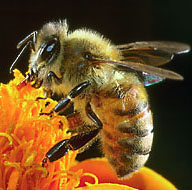|
We Do Bees: All About the Italian Honeybee
|
|||||||||||||||||||||
|
The Italian honeybee is the default bee that beekeepers use. Cal Poly is among the many beekeeping facilities that work with the Italian honeybee. Currently, this bee in particular is the only one that students and faculty are working with on campus in the bee hive facilities. In the caste system of the general honeybee, the community consists of three structurally different forms- the queen, the drone, and the worker. These castes are associated with different functions in the colony as each castes possesses its own special instincts geared to the needs of the colony. One can relate the honey bee community to our community because just as we have specific people who do specific jobs, so does the bee kingdom. For example: doctors, construction workers, teachers, presidents, etc. THE QUEEN: The queen is the only sexually productive female in the colony and thus is the mother of all drones, workers, and future queens. Her capacity for laying eggs is outstanding; her daily output often exceeds 1500 eggs, the weight of which is equivalent to that of her own body. Anatomically, the queen is strikingly different from the drones and workers. Her body is long, with a much larger abdomen than a worker bee. Her jaws contain sharp teeth, whereas her offspring have toothless jaws. She has a curved, smooth stinger that she can use repeatedly without endangering her own life. The queen bee lacks working tools including pollen baskets, beeswax-secreting glands and well-developed honey sacs. Her average lifespan is one to three years. The Worker: Unlike the queen, the worker bees stingers are straight and barbed, so that when a worker stings, the needlesharp organ remains firmly anchored in the flesh of its victim. In trying to withdraw the stinger, the bee tears its internal organs and dies shortly thereafter. These bees are what make up the colony for they are the most numerous. Workers build and maintain the nest and care for the brood. They build the nest from wax secreted from glands in their abdomen. Workers leave the hive to gather nectar, pollen, water, and propolis, a gummy substance used to seal and caulk the exterior of the nest. They convert the nectar to honey, clean the comb, and feed the larvae, drones, and the queen. They also ventilate the nest and when necessary, defend the colony with their stings. Workers do not mate and therefore can not produce fertile eggs. They occasionally lay infertile eggs, which give rise to drones. Furthermore, the worker bee does the most work, hence the name! The Drone: Drones are male honey bees. They are stingless, defenseless and unable to feed themselves so they are fed by worker bees. Their one function is to mate with new queens. Drones are prevalent in colonies of bees in the spring and summer months. As fall approaches, they are driven out of the nests or hives by the workers and left to perish. This table is straight from Media Wiki and lays out for us the good and the bad of the bee we keep here at Cal Poly. According to the table, we can see that there are a couple more pros than cons, thus making the Italian Honeybee a legit choice for beekeeping. Pros and Cons of the Italian Honeybee
|
|||||||||||||||||||||

